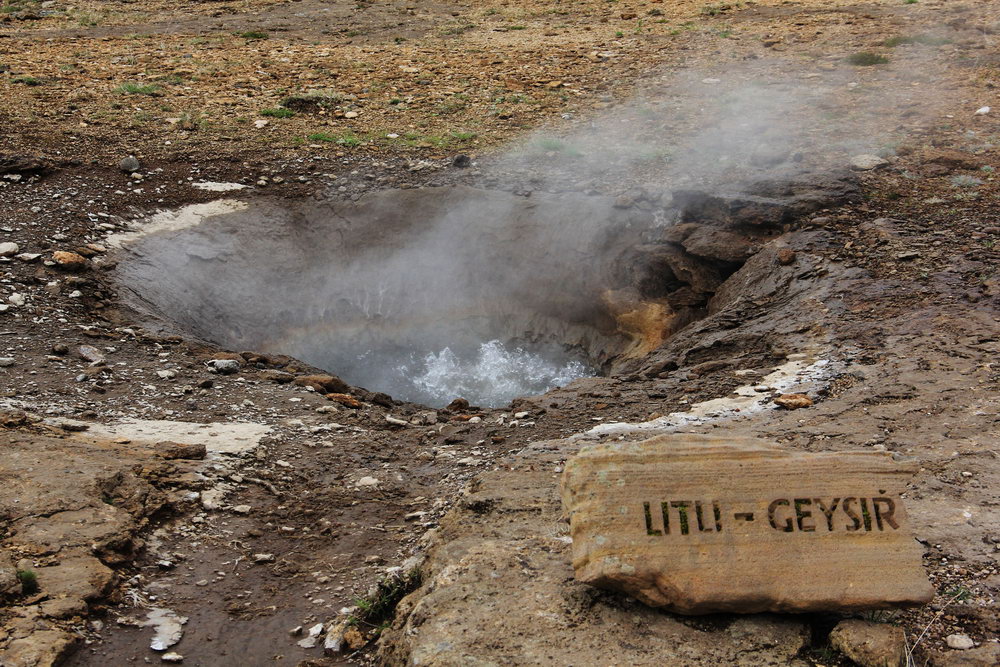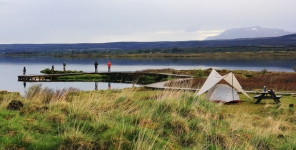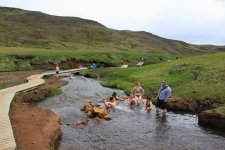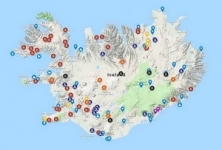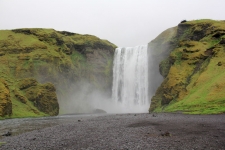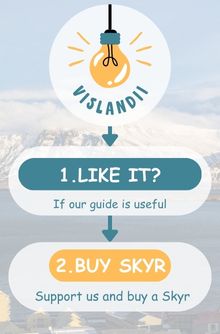Below is a list of the most common mistakes that tourists make when traveling to Iceland. Some of them may just complicate your journey, others may ruin the whole trip, and some may cost you your life!
TOP 10 Things NOT to do in Iceland:
- Rely on public transport in Iceland
- Book a hotel in Reykjavik for the duration of the trip.
- Walk off-designated paths or drive off-road.
- Expect to see the polar day in winter or the northern lights in summer
- Ignore the warning signs
- Stay overnight with a tent or in a camper in prohibited places
- Do not take a rain jacket and sunscreen with you to Iceland
- Swim only in large popular geothermal complexes
- Rely on online maps
- Plan a circular route around Iceland for a week or less
TOP 10 Things NOT to Do in Iceland
1. Rely on public transport in Iceland
Relying on limited public transport instead of renting a car is one of the mistakes people make when visiting Iceland.
In Iceland, public transport options include bus, ferry lines and domestic flights. But having visited Iceland many times already, at all seasons of the year, we recommend renting a car in order to have more freedom of movement around the country.
Of course, there are buses, but they are quite expensive, they rarely run (especially in off-season) and they can only get to the main attractions (only on the Golden Circle of Iceland).
Buses in Iceland, routes and schedules
The easiest and most popular way to travel around Iceland is to rent a car. But what if for some reason this option is not suitable for you?
Not many people kn...
And the car will allow you to move at your own pace and not waste time waiting for buses, or hurry so as not to miss the next flight. In addition, the big advantage of the car is the ability to get even to the most remote attractions. By the way, the map with the sights that we have created is available here.
2. Book a hotel in Reykjavik for the duration of the trip.
Another big mistake would be if you book a stay in Reykjavik for the entire period of your trip. This adds a lot of travel time every day from Reykjavik to the place you want to see and back (especially if you take buses).
Some of Iceland's natural wonders are located a short drive from the capital. But most of them are quite far away. You come to Iceland for the sake of nature, and staying in Reykjavik, you spend four or five hours every day on a round trip.
We recommend staying in Reykjavik for 1-2 nights at the very beginning or at the very end of your trip to see the city. And the rest of the time, spend the night in towns along the way of your trip to Iceland.
There are several options for how to arrange overnight stays - starting from a tent on the roof of your car and ending with luxury hotels that are all over Iceland. Read more about where and how you can stay overnight here!
3. Walk off-designated paths or drive off-road.
Stepping on the delicate moss that covers lava fields all over Iceland can damage it for decades.
Although Icelandic moss is able to withstand the harsh climate of the country, a slow-growing organism is very fragile, if you step on it, it will greatly damage it and may even kill it.
It grows incredibly slowly, and it may take hundreds of years for it to cover a small area.
Some routes in Iceland are closed to tourists due to the fact that people walk anywhere and trample all the vegetation around.
It is important to know and remember that you can drive a car only on officially designated roads. Off-road driving is strictly prohibited!
Also in Iceland, a huge number of birds nest in the summer and it is important to remember this and not scare the birds. Special signs are placed in nesting sites prohibiting passage and passage in this place. In addition, you should not make noise, launch quadrocopters or disturb birds in any other way, otherwise you may regret it yourself - sometimes birds can be quite aggressive (details below).
4. Expect to see the polar day in winter or the northern lights in summer
One of the very popular attractions of Iceland (which is not marked on any of the maps) is the northern Lights. However, you should not expect to see it in the summer (as well as in late spring and early autumn). Observing the aurora requires darkness (and also solar activity). And from May to September, it is almost always light in Iceland and it is almost impossible to see the aurora borealis.
Read more about where and how to see the northern Lights in Iceland here!
The opposite situation is when tourists come to Iceland in winter, they expect to see the polar day and the midnight sun. Which, of course, is impossible.
5. Ignore the warning signs
Near some of Iceland's attractions, you can find special signs that inform about the danger. They are there for a reason. Every year tourists die in Iceland because they did not heed the warnings.
Most often, such warning signs can be found:
- on the beaches - sudden waves and sea currents wash people off the shore
- near cliffs and steep slopes, a landslide may occur and a person falls off a cliff or stones may fall from above
- near geoactive zones, very hot water (boiling water), incandescent volcanic gases or even liquid lava can come to the surface
- near bird nesting sites - some bird species can be very aggressive during the nesting period and attack humans
It is worth paying very close attention to such warnings and do not go where you do not need to!
6. Stay overnight with a tent or in a camper in prohibited places
It is not necessary to set up camp in the first place you come across, it may be a private territory, and the owner of the land does not want tourists to spend the night there. In the most popular places for such "illegal" camping, there are already signs with information that camping is prohibited.
If you stay in such a place, then at best, in the evening or at night, the owner of the land may appear and tell you to pack your things and leave. In the worst case, he can just call the police.
We have already written about where and how to spend the night in a tent in Iceland here:
Camping in Iceland
If you decide to go to Iceland and want to see the nature of this beautiful island, then you can live in a hotel, in a mobile home or in a tent at a campsite. Camping ...
7. Do not take a rain jacket and sunscreen with you to Iceland
Probably many people have heard about the changeable weather in Iceland. This is true - the weather can change every 10 minutes, then rain, then sun.
Therefore, it is important not to forget to take with you a set of clothes from the rain (jacket, pants, shoes) so is everything you need for sunny weather (sunscreen, glasses).
When we were in Iceland for the first time, we had 3 days without rain in 2 weeks, and those were quite cloudy. It was cold and windy all the time, all clothes and shoes were soaked.
When we were in Iceland for the second time, we had 3 days without sun in 2 weeks. The rest of the time it was very warm, you could walk around in shorts and a T-shirt, and we were burned in the sun because we didn't take sunscreen.
8. Swim only in large popular geothermal complexes
Iceland has a huge number of hot springs - several thousand, and all tourists know only about the Blue Lagoon. Its main advantage is that it is very conveniently located between the airport and Reykjavik, and therefore it is convenient to enter it either immediately after arrival in Iceland, or right before departure.
There are many alternative geothermal spas all over Iceland that are no worse, and maybe even better.
In addition, there are hundreds of hot springs that are not as large-scale and pretentious, but they are free and no less hot than the Blue Lagoon.
10 Inexpensive Alternatives to the Blue Lagoon
Iceland is one of the most popular travel destinations in Europe, and there are especially many tourists in Iceland in the summer. But even in summer it is not very ho...
9. Rely on online maps
Are you used to the fact that you always have the Internet in the city and you can find the answer to any question on Google? When traveling in Iceland, you will not always have a connection (although there is a connection most of the way), so you need to make sure in advance that you have maps (or a navigator) which work offline - without Internet access.
There are several options for how to do this:
- offline Google maps - you need to download maps of Iceland in advance in the Google maps app
- any other app with maps for navigation in Iceland (for example maps.me )
- paper maps of Iceland's highways (we don't even know if they can still be found)
It is worth preparing in advance and seeing the route, as there are embarrassments with names in Iceland. For example, when searching for Faxi Waterfall, you can find two different waterfalls at opposite ends of the island, so be careful.
And to search for attractions, we recommend using our map of attractions:
Iceland attractions map
On this map you can find all the most important sights of Iceland. All attractions are shown on the google map, which means it will be easy for you to get directions t...
10. Plan a circular route around Iceland for a week or less
Are you planning a trip to Iceland for a week and the most logical option seems to you to go around the island by car on the 1st road?! We do not recommend it... after all, even if you do not go to the Western Fjords and the Snafjelsnes peninsula, it is already almost 1500km. It doesn't seem like much, but in Iceland you want to stop at every step, and spend more time near lagoons and rocks!
Of course, it is possible to meet in 7 days and go around the whole island, but will you enjoy chasing kilometers?!
For a trip along the ring road of Iceland without entering the Western Fjords, we recommend setting aside 9-10 days, or even better, 12-14. After all, then you can take your time, wait out the bad weather or just sit in the thermal spring overlooking the ocean, and not skip by taking just a couple of photos.
If you go to the Western Fjords, you should add 3-4 more days, and if you make several trips to the Highlands, then even more (you can spend several weeks there).
But if you still want everything at once, and you are not afraid of a trip in the style of "galloping through Europe" - then we have prepared a route for you to see the maximum and spend exactly a week:
Iceland in a week, a map and a travel itinerary!
Planning trips, namely routes, always takes a very long time. Therefore, this ready-made, 7-day Iceland trip route is what you need! There are a lot of places to visit...
This was our list of things not to do in Iceland, but read about what to do and what to see in our travel guide.

